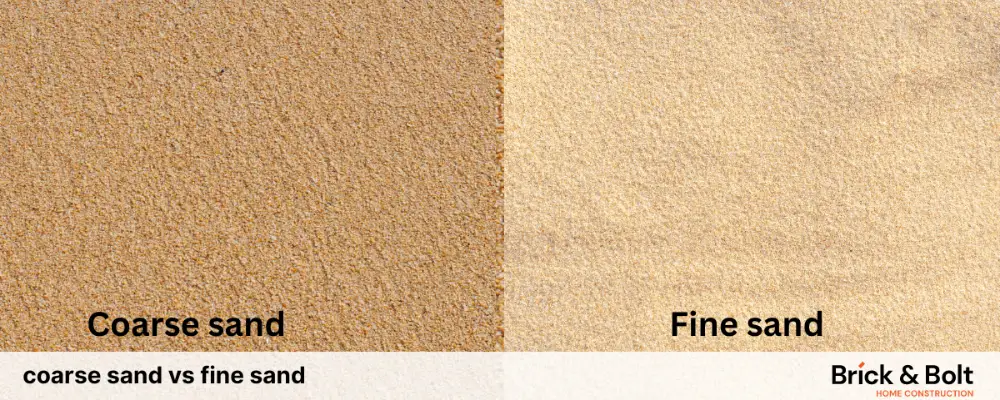Sand is an important material used in construction. It plays a vital part in creating perfect and strong concrete mixes for your homes and other structures. It also has other uses depending on specific requirements.
There are many types of sand, which can be classified based on their particle sizes and shapes, ranging from coarse sand with larger particles to fine sand with smaller particles.
In this article, we will learn about coarse and fine sand, their definitions, differences, and roles in construction.
Coarse Sand
Coarse sand is a type of sand that has larger grains and a rough texture. It is used to make drainage and concrete mixes. It is also called rough sand, grit sand, or concreting sand.
The larger particles in coarse sand allow for good water drainage. It helps water to quickly drain from the surface. This also means that coarse sand has less water retention properties.
Coarse sand is also used to produce strong concrete mixes. The larger grains in coarse sand allow the cement to be tightly bound to the sand. This improves its strength and durability.
Coarse sand can also be used on surfaces to reduce slipping. It has a rough texture that can be used on slippery surfaces like walkways, driveways, bathrooms, etc.
Fine Sand
Unlike coarse sand, fine sand has a smooth and fine texture. It has smaller grains than coarse sand and is an excellent choice for certain construction purposes. It is also called soft sand or silver sand.
Its smaller grains allow the sand to be tightly bound to one another. This creates a smooth and even surface that can be used to create a base layer for concrete, pavers, etc.
It can also retain moisture. It quickly absorbs water and distributes it evenly throughout the surface, which can be beneficial for soil moisture.
It can also be used in children’s play areas. The fine sand particles provide a soft texture that children can play on without hurting themselves. The moisture retention properties also allow for creative and fun activities like digging and shaping.
Coarse Sand Vs. Fine Sand
The main difference between coarse and fine sand lies in the size of their respective particles. It influences their properties, performance, and applications. The table below depicts some major differences between coarse and fine sand.
| Coarse Sand | Fine Sand |
| It has larger grains, around 0.5mm to 2mm. | It has smaller grains, around 0.075mm to 0.425mm. |
| Particles are irregular in shape and size | The particles are more even and rounded. |
| It has a rough texture. | It has a smooth texture. |
| It has excellent drainage properties due to its larger grain size, allowing water to flow freely. | It has poor drainage facilities due to smaller grains, which can lead to accumulating water. |
| It has low water retention properties. | It has high water retention properties. |
| Coarse sand is less expensive than fine sand. | Usually more expensive than coarse sand. |
| It is used in concrete, drainage, and various other purposes. | It is used in mortar, sandboxes, and other specific purposes. |
Which Sand is Better for Construction?

Coarse sand and fine sand have their own properties and distinctive qualities. They are useful for different types of construction and landscaping purposes. Below are some major applications of coarse sand and fine sand.
Coarse Sand
- Used as an important component in concrete mixes.
- Used as a stabilizing material in road construction for better drainage and support.
- Used in landscaping for better drainage.
- Used as a stable foundation for pavers.
- Used in water and waste treatment plants for better drainage of waste particles.
Fine Sand
- Used in mortar to bind bricks and blocks.
- Used in plastering to create smooth walls and ceilings.
- Used to create sandboxes for children’s play area.
- Used in beach replenishment projects.
- Used as a raw material in glassmaking.
Technical Guidelines for Selecting Sand
1. Particle Size Distribution:
The particle size of sand helps achieve better compaction and strength and reduces voids in the mix. For this, ensure the sand has a well-graded mix of particle sizes.
2. Shape and Texture of Sand Grains
Always prefer angular or sub-angular grains, which provide better interlocking and bonding strength in construction than smooth and rounded grains.
3. Cleanliness and Impurity Levels
It is advisable to ensure the sand is free from organic materials, silt, clay, and other impurities that can weaken the concrete or mortar.
4. Moisture Content
Moisture content in sand plays a huge role in construction stability. Excess moisture content in sand can affect the concrete mix, while insufficient moisture may lead to poor workability.
5. Durability Requirements
Sand durability is crucial when it comes to withstand environmental conditions the structure will face. It should be able to resist weathering and not degrade over time.
6. Local Availability and Cost
Going with locally available sand is a smart option to avoid transportation costs. On the other hand, the sand must meet the quality standards before being used for construction.
7. Supplier Quality Assurance
Work with suppliers who can provide high-quality sand with proper documentation and testing reports.
Conclusion
Coarse sand and fine sand have their own uses in construction and landscaping. Before choosing one, understand your requirements well. Choose the one that best suits your needs. You can consult a professional if you want to get a clear idea of which one to buy.
FAQs
Coarse sand has larger grains, around 0.5mm to 2mm. Fine sand has smaller grains, around 0.075mm to 0.425mm.
Coarse sand promotes good drainage due to larger grains, allowing water to flow freely. Fine sand has poor drainage facilities due to smaller grains and can accumulate water. This makes coarse sand the best choice for surfaces that require higher drainage facilities.
Fine sand is more expensive than coarse sand. The cost depends on factors like availability, demand, and processing time.

